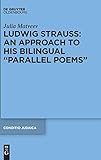Ludwig Strauss: An Approach to His Bilingual “Parallel Poems” / Julia Matveev.
Material type: TextSeries: Conditio Judaica : Studien und Quellen zur deutsch-jüdischen Literatur- und Kulturgeschichte ; 93Publisher: München ; Wien : De Gruyter Oldenbourg, [2018]Copyright date: ©2018Description: 1 online resource (XII, 224 p.)Content type:
TextSeries: Conditio Judaica : Studien und Quellen zur deutsch-jüdischen Literatur- und Kulturgeschichte ; 93Publisher: München ; Wien : De Gruyter Oldenbourg, [2018]Copyright date: ©2018Description: 1 online resource (XII, 224 p.)Content type: - 9783110587500
- 9783110587630
- 9783110590760
- 892.415 23/ger
- PT2639.T77 Z76 2018
- online - DeGruyter
- Issued also in print.
| Item type | Current library | Call number | URL | Status | Notes | Barcode | |
|---|---|---|---|---|---|---|---|
 eBook
eBook
|
Biblioteca "Angelicum" Pont. Univ. S.Tommaso d'Aquino Nuvola online | online - DeGruyter (Browse shelf(Opens below)) | Online access | Not for loan (Accesso limitato) | Accesso per gli utenti autorizzati / Access for authorized users | (dgr)9783110590760 |
Frontmatter -- Contents -- Acknowledgments -- 1. Introduction -- 2. Strauss’S Politico-Religious Views -- 3. Poetry As A »Fore-Image« Of True Community -- 4. The Poem »To The Bay« And The Issue Of Translation -- 5. Analysis Of The Poems »Morning Song« And »Twilight« -- 6. Commentary To »My Olive Branches« And »Under The Olive Tree« -- 7. Four Other »Parallel Poems« -- 8. Concluding Remarks -- Bibliography -- Index
restricted access online access with authorization star
http://purl.org/coar/access_right/c_16ec
This book is devoted to the study of the bilingual “parallel poems” of Ludwig Strauss (Aachen 1892 ˗ Jerusalem 1953) created between 1934 and 1952 in Palestine/Israel and which exist in two variants, a Hebrew and a German version, one of which is the original and the other a self-translation. The aim of this study is to compare the versions and their interpretation based on Strauss’s theoretical essays on poetry and translation, his political writings and works of literary criticism. Special attention is paid to Strauss’s concept (linked with the idea of messianic redemption) of poetry as a “fore-image” of a future true community of men and as “the earthly expression of the Absolute” directed at interpreting divine revelation and its “translation” into human language. In examining Strauss’s experiments with self-translation, by which he aimed at establishing a dialogue between languages, and between people and nations, this study considers the two processes of translation: from divine speech into human language and from one human language into another.
Issued also in print.
Mode of access: Internet via World Wide Web.
In English.
Description based on online resource; title from PDF title page (publisher's Web site, viewed 28. Feb 2023)


